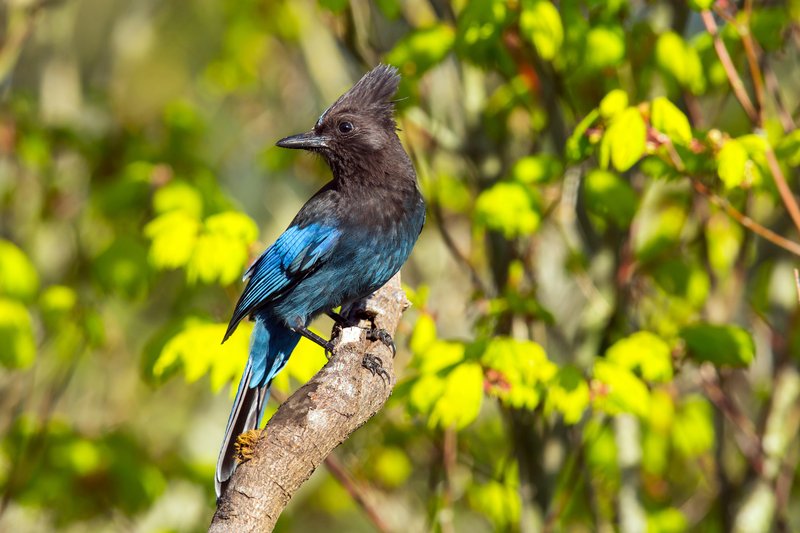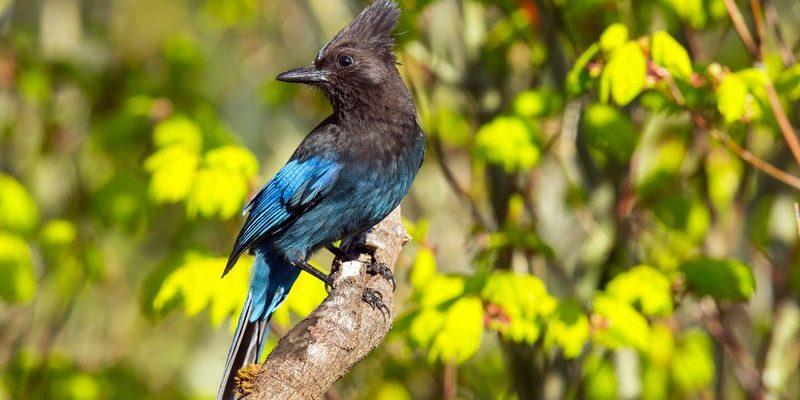
The Steller’s Jay, with its striking blue and black plumage, is a feathered friend that often catches the eye of birdwatchers and casual observers alike. Imagine a lively character with a bold personality and a penchant for loud calls. That’s the Steller’s Jay! This bird isn’t just about looks; it’s known for its intelligence and adaptability, making it a fascinating subject for anyone interested in wildlife.
Native to the western part of North America, Steller’s Jays thrive in diverse habitats, from coniferous forests to mountain ranges. They’re part of the corvid family, which also includes crows and ravens, hinting at their clever nature. If you’ve ever spotted one hopping around a campsite or stealing a snack, you know they aren’t shy about getting close to humans. With their playful antics, these birds not only brighten our natural surroundings but also make for an interesting study.
Physical Characteristics
When it comes to physical appearance, the Steller’s Jay is hard to miss. Adult Steller’s Jays typically measure about 11 to 12 inches in length, sporting a distinctive crest on their head that adds to their charm. Their feathers are a vibrant blue, which can sometimes appear almost purplish, contrasted beautifully by a rich black on their heads and wings. This coloration isn’t just stunning; it plays a role in their social interactions, helping them communicate with one another.
Their beak is strong and pointed, ideal for cracking open nuts and seeds, and they have a robust body that allows them to be agile in trees and on the ground. A closer look reveals that their legs and feet are built for climbing, making them equally comfortable scurrying across branches or hopping on the ground searching for food.
Juvenile Steller’s Jays, however, have a different look. They often appear more muted, with grayish feathers that gradually evolve into the striking blue we associate with adults. This change in plumage not only signals maturity but also reflects their growing independence as they learn the ropes of survival in their environment.
Habitat and Distribution
Steller’s Jays are primarily found in the western regions of North America, from southern Canada down to California and all the way to Mexico. They prefer mountainous landscapes, yet they are quite versatile when it comes to their habitat choices. You might find them in coniferous forests, mixed woodlands, and even in urban parks where trees are abundant. They adapt well to both natural and human-altered environments, often striking up a presence near campsites and picnic areas.
These birds are social creatures and often form small flocks. During the warmer months, you’ll see them in larger groups, typically foraging together. As winter approaches, they become more solitary, although they still gather in twos or threes. Their adaptability plays a significant role in their survival. When food sources are limited during colder months, Steller’s Jays can adjust their diets, showcasing their intelligence in foraging for diverse food types.
Their distribution can sometimes overlap with other jay species, but Steller’s Jays can often be distinguished by their striking coloration and behaviors. They play a crucial role in their ecosystems as seed dispersers, aiding the growth of new trees and plants, thus supporting the habitats they thrive in.
Diet and Feeding Habits
The Steller’s Jay is an omnivore, which means it enjoys a varied diet. Their primary food sources include berries, seeds, nuts, and insects. Steller’s Jays have a particular fondness for acorns, which they collect and store for later use. This caching behavior is a clever survival tactic, allowing them to have food readily available during the winter months when resources are scarce.
What’s fascinating is their ability to adapt their diet based on what’s available. In urban areas, you might see them raiding bird feeders or scavenging leftover food from picnics. They are known for their inquisitive nature, often investigating human activities to find an easy meal. Their intelligence shines through in how they use their problem-solving skills to access food, whether it’s figuring out how to open a container or working in pairs to distract humans while the other sneaks food.
Steller’s Jays also exhibit social feeding behaviors. When they spot food, they often call out to other jays, inviting them to join. This not only enhances their chances of finding food but also strengthens social bonds within the flock. So, if you hear a raucous call while you’re out and about, it just might be a Steller’s Jay inviting its friends to a feast!
Breeding and Nesting
Breeding season for Steller’s Jays typically occurs from late spring to early summer. During this time, males become particularly vocal, showcasing their strength and desirability through a variety of calls and displays. Pair bonds are usually monogamous and can last for several seasons, which is interesting compared to some other bird species.
Nesting usually takes place in trees, specifically in coniferous or oak trees, where branches provide shelter and safety. The female takes the lead in building the nest, using twigs, grasses, and other plant materials to create a cozy environment for her eggs. Nests are often hidden to protect young chicks from predators, which showcases their instinctual protective behaviors.
After laying a clutch of three to five eggs, the female incubates them while the male helps by bringing food. Once the chicks hatch, they are altricial, meaning they are born helpless and rely entirely on their parents for care. The parents work hard to feed their young, bringing a variety of food to help them grow strong. After about three weeks, the fledglings are ready to leave the nest, a moment where the parents’ hard work truly pays off.
Behavior and Social Structure
Steller’s Jays are known for their bold and curious nature. They are quite social, often found in small groups, especially when foraging for food. Within these groups, you’ll notice a clear hierarchy, with dominant individuals often having priority access to food sources. This social structure helps ensure that each jay can thrive in its environment, despite competition for resources.
Besides their social interactions, their behavior is marked by some fascinating traits. Steller’s Jays are highly vocal, using a range of calls to communicate. From warning calls to attract mates, their vocalizations play a crucial role in their daily life. You might find them mimicking other birds and sounds, showcasing their intelligence and adaptability. Think of them as the comedians of the bird world, often entertaining those lucky enough to observe their antics.
One interesting behavior to note is their caching or storing of food. During the warmer months, they collect acorns and nuts, hiding them for later consumption. This clever technique not only provides a food reserve but also contributes to forest regeneration, as some of the cached seeds grow into new trees. It’s an excellent example of how even small actions by animals can have a big impact on their ecosystem.
Conservation Status
Currently, the Steller’s Jay is not considered to be at risk, with a stable population across its range. However, like many species, they face challenges due to habitat loss and environmental changes. As urban areas expand, their natural habitats are often compromised, which can affect their food sources and nesting sites. Additionally, climate change poses a long-term threat to their habitats, altering the ecosystems they depend on.
Conservation efforts are essential to ensuring that these vibrant birds continue to thrive. By preserving their natural habitats and ensuring biodiversity in the ecosystems where they live, we can help maintain healthy populations of Steller’s Jays. Birdwatchers and nature enthusiasts can play a role by supporting local conservation initiatives and enjoying their presence in the wild responsibly.
In addition to habitat protection, raising awareness about the ecological roles of Steller’s Jays can lead to greater appreciation for these birds. Their importance in seed dispersal and ecosystem maintenance makes them a valuable species in the natural world, and protecting them benefits the broader environment. By fostering a connection between people and wildlife, we can ensure future generations of bird lovers can enjoy the beauty of the Steller’s Jay.
The Steller’s Jay is more than just a pretty face; it’s a clever, adaptable bird that plays a vital role in its environment. From its striking appearance to its interesting behaviors, learning about this bird can deepen our appreciation for the natural world. Whether you’re a seasoned birdwatcher or a casual observer, keep an eye out for these beautiful birds — their playful antics and vibrant colors are sure to bring a smile to your face. Next time you’re out in nature, take a moment to enjoy the charm of the Steller’s Jay and the lively stories it has to tell.
FAQ
What is the size of a Steller’s Jay?
A Steller’s Jay typically measures about 11 to 12 inches in length. They have a wingspan of approximately 16 to 22 inches, making them a medium-sized bird with a robust body and a distinctive crest on their head.
Where can I find Steller’s Jays?
Steller’s Jays are primarily found in the western parts of North America, including areas in Canada, the United States, and Mexico. They thrive in diverse habitats, primarily in coniferous forests and oak woodlands, but can also adapt to urban environments.
What do Steller’s Jays eat?
Steller’s Jays are omnivorous and have a varied diet that includes berries, seeds, nuts, and insects. They are also known for scavenging human food, particularly in campsites and parks, where they may raid bird feeders or picnic leftovers.
Are Steller’s Jays social birds?
Yes, Steller’s Jays are highly social creatures. They often form small flocks, especially during foraging, and exhibit social behaviors such as vocal communication and caching food. This social structure helps them navigate their environment effectively.
How do Steller’s Jays nest?
Steller’s Jays typically build their nests in trees, using materials such as twigs, grasses, and leaves. The female usually takes the lead in building the nest, which provides a safe environment for her eggs and chicks.
What is the lifespan of a Steller’s Jay?
The average lifespan of a Steller’s Jay is around 3 to 4 years in the wild, although some individuals have been known to live longer under favorable conditions. Various factors, including food availability and predation, can influence their longevity.
Are Steller’s Jays good at mimicking sounds?
Yes! Steller’s Jays are known for their vocal abilities and can mimic a wide range of sounds, including those of other birds. Their playful nature often leads them to imitate sounds in their environment, making them quite entertaining to observe.
How do Steller’s Jays contribute to their ecosystem?
Steller’s Jays play a crucial role in their ecosystem as seed dispersers. By caching acorns and other seeds, they unintentionally aid in forest regeneration, fostering the growth of new plants and contributing to biodiversity.
Can I attract Steller’s Jays to my backyard?
Yes, you can attract Steller’s Jays to your backyard by providing bird feeders filled with nuts, seeds, and fruits. Additionally, planting native trees and shrubs that produce berries can create an inviting habitat for them.
What is their breeding behavior like?
Steller’s Jays typically form monogamous pairs during the breeding season, which occurs in late spring to early summer. The female builds the nest, while both parents share the responsibility of feeding and caring for the chicks once they hatch.
Do Steller’s Jays have any natural predators?
Yes, Steller’s Jays face threats from various predators, including hawks, owls, and snakes. Nestlings are particularly vulnerable to predation, which is why the placement of nests in trees provides them with some level of safety.
How do climate changes affect Steller’s Jays?
Climate change can impact Steller’s Jays by altering their habitats and food sources. Changes in temperature and precipitation patterns can affect the availability of food and suitable nesting sites, making it essential to monitor their populations and habitats closely.

